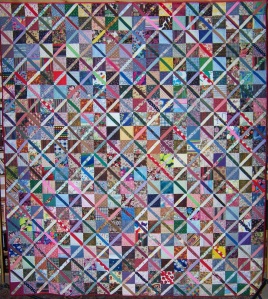Each May for many years now, Nevada City resident Mary Moore has donated one of her handmade quilts to the North San Juan Fire Auxiliary’s Scotch Broom Breakfast raffle. A nationally known quilting queen and artisan, Moore is incredible unassuming and humble about her talents. This article was first published in the May 2009 North San Juan Volunteer Fire Department’s biannual newsletter, and was published again in my old blog “The Eddy”.

The grand prize for the 2011 Scotch Broom Raffle, which benefits the North San Juan Volunteer Fire Department. For an enlarged photo see the end of the article, and email me at lightcapfarm@gmail.com if you want to buy a ticket. The 2009 winner bought only one ticket!!!
from the archives:
Writer’s note: On April 24, 2009, artist Mary Moore treated me to a trunk show in her home. A trunk show, traditionally, is a show a quilter gives a person, all the quilts making it out of the trunk for display. In the two hours I spent in her sunny loft, I saw photos of dozens of quilts—and at least a dozen quilts out of the trunk. Each one has a rich story stitched into it. Moore is also a weaver and a painter. A woman of seemingly boundless energy, she shared her art with me with the enthusiasm of a girl just starting an inspiring project. Tempering her enthusiasm is a lovely, quiet wisdom. It was an honor to spend this time with her. Here are a few things I learned from Mary’s trunk show. –Carolyn Crane
On most days, when Mary Moore needs to sew something up, she uses a Red Eye, a treadle Singer machine she picked up in Nevada City for $75. It’s worked great since that first half hour greasing she gave it, when she patiently turned the treadle and the wheel while the oil seeped in. It’s one of five sewing machines she has, and by far the simplest.
Moore started quilting over forty years ago. “My hands need to keep busy,” she explains, so working as a librarian and starting a new family weren’t quite enough for her ambitious fingers. The young woman had been making sweaters, but fabric was much cheaper than wool, and times were tight. “My hoop wasn’t expensive. Sears Catalog still sold fabric by the pound and you didn’t know what you were going to get! That was so fun!” Her first quilt showed an array of scenes from her favorite children’s books—books she was looking forward to reading to her newborn son. Her appliqué was primitive but she was on her way. The project also gave her a sense of permanence in the whirlwind of working-young-motherhood. “However many stitches I put in, they stayed in at the end of the day. Whatever else happened with the baby and the house and trying to get to work, was a little spot of something I finished.”
Since then, Moore has finished hundreds of quilts. She has matured into a quilting teacher and designer. Her quilting has become part of the emotional glue that holds family and community together.
During her career as a librarian, Moore and her husband Paul (a high school English teacher) worked and lived near Lake Arrowhead in the San Bernadino Mountains. When they retired several years ago, they moved to the San Juan Ridge. “We’ve always lived in the mountains,” Moore explains. They moved to the Sierra in order to be closer to their son and his family, and built most of their home on Cruzon Grade by themselves. As soon as the roof was securely overhead, they began to volunteer. “At one point I was volunteering at every organization on Tyler-Foote that would take a volunteer,” she remembers. Paul was doing the same. Today, each one is a treasurer for a local cause: Paul for the NSJ Fire Auxiliary, and Mary for Malakoff State Park.
Up here on the Ridge, it only took a few months for Mary’s passion for community to meet up with her passion for quilting. Five years ago, Moore’s quilts stepped in to continue the long tradition of the Auxiliary raffling a quilt each Mother’s Day. The process was familiar to her. Nearly as soon as she began quilting, she began donating her quilts to raffles and auctions. “Because there was no one else doing it, I was the best there was,” she recalls. One particular donation was healing for Moore. “Our first baby did not live long, and she was taken care of beautifully in a hospital in the next town. I had never gone to thank them, because I couldn’t bring myself.” Months later, Moore remembers, a woman came into her library looking for the woman who did quilts. She was searching for an auction item for the very hospital that cared for Moore’s daughter. Handing over a quilt to St. Bernadine’s was a comfort to her. Quilting also became a daily ritual for Moore and her mother in the last ten years of her mother’s life. Mary taught her mother how to quilt (she was by then teaching classes regularly), and her mother went on to win numerous awards, including the honor of displaying three of her quilts at the grand opening of the Ronald MacDonald house.
During her years in Lake Arrowhead, Moore was active in a quilting guild that grew to 65 members. The guild supplied hospitals and other charities with hundreds of quilts, many of them quilt-of-the-month or challenge quilts. Here on the Ridge, Moore is working on the Ridge History tapestry project in addition to her many hours of volunteer time.
During the forty years she’s been quilting, every aspect of her technical skill as a quilter has steadily improved. From the first simple appliqué of the story books destined for her son, Moore developed sophisticated appliqués that utilized shadows with human shapes and three dimensional objects. At the same time, Moore studied the variations of quilting designs. She traveled to Norway with quilters, taking with her a watercolor quilt she’d made with fabric from 35 countries. The quilt, while in someone else’s hands, disappeared in either Switzerland or Russia.
Moore considers this year’s quilt, a Welsh design, to be the culmination of her practice and study thus far. Welsh quilts are a departure from the American and English designs, she explains. Typically quilts are made from small pieces of fabric; they evolved as an economical way to create a blanket out of scraps, and from there an art form developed. In 19th Century Wales, however, quilt design grew out of the emerging middle class. Suddenly, women could afford swathes of gorgeous fabric, and they were loathe to cut them up in tiny pieces. They also couldn’t bear to cover even a half inch of the fabric with a border, so there is none. The women would select the fabric and create the design, then hire a quilter to stitch the entire piece. The quilter worked with the solid back of the quilt, never looking at the fabric on the front. The design the quilter creates is its own art. “I’ve never had so much fun quilting!” Moore says. She free-quilted a variety of designs, including paisleys, hearts, and, for fun, specific objects such as sewing scissors.
Moore keeps a piece of paper handy in her sewing room. It’s a list of her future plans for quilts, and she hopes to raffle them off to support her local firefighters. Her future quilt dreams include a crazy quilt, a theme quilt about a fire department, and a quilt depicting local Indian baskets. Since she works on her quilting a minimum of three to four hours a day, her neighbors won’t have to wait too many years to witness first hand the continued evolution of a true artist and philanthropist.


Took me sometimes to read some the comments, any way I admittedly enjoyed the post. It proved to be pretty beneficial to me and I am sure to all the commenters right here! It’s always good when you can not only be informed, but also entertained!